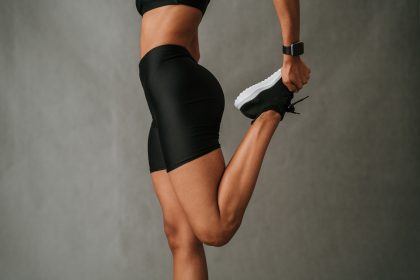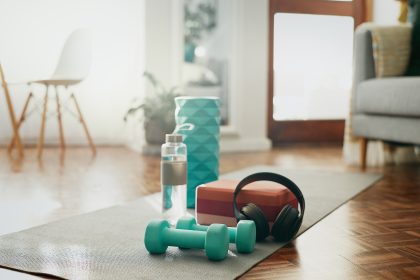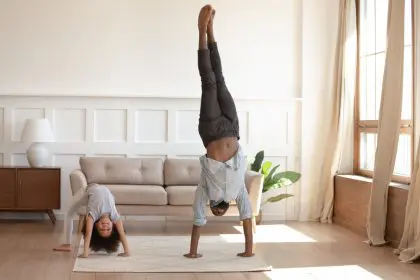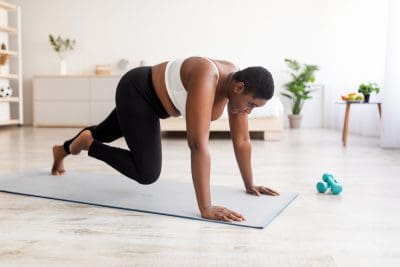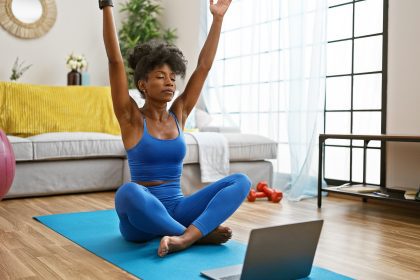Finding room to exercise can present a genuine challenge for apartment dwellers, frequent travelers, or anyone navigating life in compact quarters. The good news? Limited square footage need not limit fitness progress. With thoughtful planning and creative approaches, even the smallest spaces can transform into effective workout zones that deliver results comparable to fully equipped gyms. These innovative strategies help maximize minimal space while still providing comprehensive fitness benefits.
Wall-based resistance training
Vertical surfaces represent vastly underutilized real estate in small spaces. Walls provide stable support for numerous effective exercises that build strength without requiring bulky equipment. The wall sit exemplifies this concept perfectly—simply position your back against a wall, lower into a seated position with thighs parallel to the floor, and hold. This isometric exercise engages quadriceps, hamstrings, and core muscles simultaneously while requiring zero floor space.
Wall pushups offer an adaptable alternative to traditional floor versions, particularly beneficial for beginners or those building back strength after injuries. Standing at arm’s length from a wall, place palms flat against the surface and perform pushups by bending and straightening arms. Adjust difficulty by increasing distance from the wall or transitioning to a single-arm variation for advanced practitioners.
For lower body development, wall slides deliver exceptional quadriceps activation. Standing with your back against a wall, feet shoulder-width apart and slightly forward, slide downward until knees reach 90-degree angles, then push back up. The controlled movement maintains constant tension on muscles while the wall ensures proper form—particularly important for preventing knee injuries during squatting movements.
Small adhesive hooks installed at strategic heights create anchor points for resistance bands, instantly expanding exercise options to include pulls, presses, and rotational movements. This system weighs virtually nothing, costs little, and can be removed without damaging walls, making it ideal for renters and travelers.
Furniture-integrated fitness
Everyday furniture items double as versatile fitness equipment with minimal adaptation. A sturdy chair supports numerous effective exercises that build functional strength. Chair dips target triceps and shoulders—simply grip the front edge of a seat, position feet forward with legs extended, then lower and raise your body by bending and straightening arms. For increased difficulty, elevate feet on another surface or add weight to the lap.
The same chair facilitates split squats by placing one foot on the seat behind you while lowering into lunges. This exercise demands minimal horizontal space while thoroughly engaging quadriceps, hamstrings, and glutes. The elevated position creates greater range of motion than standard lunges, producing superior muscle activation even without added weights.
For core strengthening, position yourself at the edge of a bed or sofa for supported leg raises and knee tucks. These movements effectively target lower abdominals—often the most challenging area to engage—without requiring floor space. The slight instability of softer surfaces adds a balance challenge that further activates stabilizing muscles.
Coffee tables or ottomans support modified plank positions and incline pushups, allowing precise control over exercise difficulty. By adjusting body position relative to the furniture piece, the same basic movement can progress from beginner to advanced levels without requiring different equipment or additional space.
Cardio innovations for confined areas
Cardiovascular training often seems most challenging in limited spaces, yet several effective options exist that generate minimal noise and require surprisingly little room. Jump rope workouts rank among the most space-efficient cardio exercises, requiring just a few square feet of clearance. Modern weighted ropes provide adjustable resistance levels, while cordless versions eliminate ceiling height concerns while still delivering an effective workout through simulated movement patterns.
High-intensity interval training (HIIT) utilizing bodyweight exercises offers another compact cardio solution. Alternating between exercises like mountain climbers, jumping jacks, high knees, and burpees for short, intense intervals followed by brief recovery periods creates significant cardiovascular demand while keeping movements contained to a small area. Modified versions of these exercises reduce impact for noise-sensitive environments—replacing jumps with step-out movements maintains effectiveness while minimizing sound.
Portable stepping platforms fold flat for storage yet provide surprisingly effective cardio workouts when deployed. Even a sturdy hardcover book or short stack of magazines can serve as a makeshift step for basic stepping patterns. Concentrate on proper form and steady rhythm rather than step height to maintain cardiovascular benefits despite the lower elevation.
For those concerned about disturbing neighbors, low-impact cardio sequences using flowing movements from disciplines like tai chi or controlled kickboxing combinations generate minimal floor vibration while still elevating heart rate. These movement patterns can be performed in extremely limited spaces—even a 4×4 foot area provides sufficient room for effective practice.
Vertical space utilization
Looking upward reveals additional fitness opportunities in small spaces. Door frame pull-up bars install and remove in seconds without tools or permanent modifications, instantly creating options for upper body and core training. Beyond traditional pull-ups, these devices support leg raises, knee tucks, and hanging oblique work that strongly engage core muscles.
Suspension trainers anchor over doors or to ceiling hooks, requiring minimal installation while enabling hundreds of effective exercises through a single piece of equipment that stores in less space than a pair of shoes. The adjustable straps allow progressive resistance by changing body position, making them suitable for all fitness levels without requiring multiple pieces of equipment.
Foldable wall-mounted equipment represents another vertical space solution. Options range from compact folding squat racks to murphy bed-style weight benches that deploy for workouts and store flat against walls when not in use. While these require more permanent installation than other solutions, they provide serious strength training capabilities with minimal footprint.
For less permanent options, tall bookcases or shelving units can be repurposed as bodyweight training stations. A sturdy bookcase supports incline pushups, assisted pistol squats, and modified rows when properly secured, effectively becoming a multi-station gym that serves double duty as storage furniture.
Micro-equipment with macro results
Several highly effective fitness tools occupy minimal space while providing substantial training benefits. Resistance bands represent perhaps the ultimate space-efficient fitness tool—a complete set storing in less volume than a small book while offering progressive resistance for virtually every major muscle group. Modern layered bands allow precise resistance adjustment, effectively replacing entire racks of dumbbells.
Adjustable dumbbells with removable plates or selector mechanisms consolidate multiple weights into a single compact unit. Though slightly larger than bands, these systems provide the distinct benefits of free weight training while requiring a fraction of the space of traditional dumbbell sets.
Weighted clothing items like vests, ankle weights, and wrist weights add resistance to ordinary movements without requiring additional space. Wearing these during regular activities or while performing bodyweight exercises increases metabolic demand and muscle engagement without expanding the workout footprint.
Sliders or gliding discs—small platforms that reduce friction on floors—create challenging variations of standard exercises while taking up virtually no storage space. Placing these under hands or feet during movements like lunges, mountain climbers, or planks increases muscle activation through stability challenges and expanded ranges of motion.
Exercise in confined spaces requires creativity and adaptation, but need not compromise effectiveness. By viewing walls as workout stations, furniture as fitness equipment, and investing in space-efficient tools, even the most compact living situations accommodate comprehensive fitness routines. The key lies in reimagining limitations as opportunities—seeing potential exercise stations where others see obstacles. With thoughtful planning and these innovative approaches, physical constraints need never limit fitness progress.


